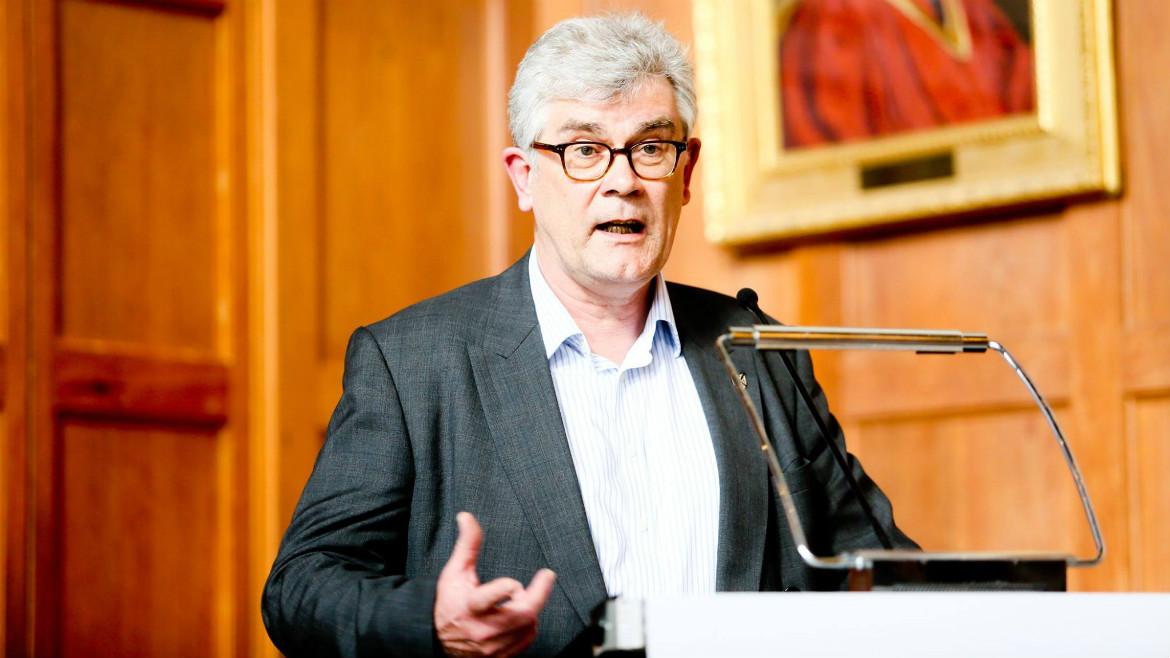COVID-19 and higher education

Tony Gallagher is a Professor at the School of Social Sciences, Education and Social Work, at Queen's University Belfast.
Since the early 2000s an important focus for his work has been on shared education and on the development of collaborative school networks, which involves collaboration between schools from different communities in divided societies aimed at promoting social cohesion and school improvement.
He has also been actively co-operating with the International Consortium for Higher Education, Civic Responsibility and Democracy and the Council of Europe on questions linked to the democratic mission of higher education. He co-authored the publication “Higher education for democratic innovation” (Council of Europe Higher Education Series No. 21, 2016), and more recently the article “Universities must help shape the post-COVID-19 world” on University World News.
In a time of plague
In Sophocles’s famous play from 429 BCE, Oedipus becomes King of Thebes while a plague was ravaging the country. Advice from the Oracle at Delphi suggested the plague was a consequence of religious pollution, as the murderer of the previous King had never been discovered. Oedipus vows to find the killer, unaware that it is he. The play ends in tragedy when Oedipus discovers not only that he is guilty of patricide, but of incest, as he has unknowingly married his mother. He gouges out his eyes in despair.
Only eccentrics would attribute the COVID-19 health crisis to an analogous moral cause, but there is little doubt that the dramatic impact of the virus has shaken many well-established assumptions about ‘normality’. Every crisis leaves some element of change in its wake and this crisis will be no different, and one of the lessons of the 1918 ‘Spanish’ Flu pandemic is that education is likely to be one of the most enduring public policy dilemmas arising from the crisis (Barry, 2009).
The impact of COVID-19 on education
UNESCO estimated that, worldwide over 1 billion children and young people stopped attending school regularly, amounting to two-thirds of enrolled learners as 144 countries closed their school systems entirely[1]. Similar global lockdowns affected higher education institutions (HEIs) as they rapidly transitioned to online platforms[2].
The immediate focus for many higher education leaders was the potential fall in income because of the collapse of student markets[3], and uncertainty on how and when campuses could reopen safely. The immediacy of the crisis brought out positive responses, as medical, nursing, social work and other health-care related academics joined the clinical and research campaign to tackle the virus, or final year medical and nursing students were fast-tracked to graduation so they could help health systems many feared might be overwhelmed[4]. Others repurposed facilities, including engineers who designed, and sometimes produced, much needed personal protective equipment.
But what will be the more enduring changes to higher education? The Economist Intelligence Unit explored possible recalibration of existing trends (EIU, 2020), though it seemed possible that the financial impact of the crisis could produce retraction in higher education generally. The problems arising from global supply chains for equipment, allied with restrictions on travel, may encourage a new wave of autarkic responses by governments and a reduction in the number of students willing, or allowed, to travel internationally to access higher education.
The economic recession provoked by the COVID-19 crisis has already produced widespread job losses with at least two possible outcomes for higher education. Poor labour market conditions might provide an incentive to reskill to enhance employment options once the crisis subsides. On the other hand, if the crisis is very severe it could provoke emergency measures which bypass higher education altogether to more directly support job creation[5].
The rapid shift towards online provision is likely to have enduring consequences. Remote teaching in schools has had mixed consequences, with many young people disengaged from learning or unable to take advantage of online provision. The evidence for higher education is less clear, but there are emerging concerns that similar patterns can be found[6] and there are fears the crisis has exacerbated the levels of inequality that already existed in many societies[7].
This may be due to the fragility of so much of our social infrastructure and a consequence of the long period of neoliberal policy dominance. During this period higher education expanded, but in pursuit of a skills-based human capital goal, and there was a narrowing of purpose that implied higher education was primarily about gaining career-related skills and credentials[8]. The neoliberal entrepreneurial university is more engaged with society, but the predominant form of engagement is with business and industrial interests, rather than a progressive social agenda. One outcome of the health crisis could be a doubling-down on that narrow economic agenda, justified by the need to rebuild the economy.
A better way forward?
There is an alternative. After the 1918 flu epidemic, schools in the United States changed completely under the influence of progressive reformers[9]. We could see a more determined effort to tackle the wider social inequalities that limit access to higher education. The Black Lives Matter movement has highlighted the need to foreground previously marginalized voices[10] and promote real change in institutional priorities[11]. We could see a move towards a democratic higher education focused on the priorities of fairness, inclusion and sustainability. The health crisis has reminded us of the importance of social solidarity, and the need for resilient social and civic institutions and democratic higher education could provide a lead for a renewed commitment to democratic values and practice in society as a whole.
There have been many within higher education moving in this general direction, including the International Consortium for Higher Education, Civic Responsibility and Democracy[12] , the Talloires Network[13] and the Global University Network for Innovation[14]. The Council of Europe project on Competences for Democratic Culture[15] and the European Commission project on a framework for community engagement[16] provide practical guidance on ways these ideas might be put into practice.
Conclusion
After the Second World War there were about 500 universities worldwide and today that number is closer to 10,000. Universities have always embodied multiple purposes, but in recent decades that sense of purpose has narrowed. The COVID-19 crisis has exacerbated existing inequalities and highlighted weakness in the capacity of our core social and civic institutions. Major crises lead to change, often building on strands of activity already in place. There has been a growing global movement highlighting the social and civic potential of higher education institutions as a force for positive social change. If these hopes are to be realized it will require a commitment to democratic higher education, based on partnership with communities across society, and an agenda for teaching and research which seeks to address and overcome the major social challenges of inequality and injustice.
References
Barry, JM (2009) The Great Influenza: the story of the deadliest pandemic in history, Harmondsworth: Penguin
Economist Intelligence Unit (2020) New Schools of Thought: innovative models for delivering higher education, London: Economist
[1] https://en.unesco.org/covid19/educationresponse [last accessed June 23, 2020]
[2] https://theconversation.com/coronavirus-universities-are-shifting-classes-online-but-its-not-as-easy-as-it-sounds-133030 [last accessed June 23, 2020]
[3] A NAFSA survey of US Colleges suggested that they were facing $ billions of lost revenue https://www.nafsa.org/policy-and-advocacy/policy-resources/survey-financial-impact-covid-19-international-education [last accessed June 23, 2020] as did a report from the Lecturers’ Trade Union in the UK https://www.ucu.org.uk/media/10871/LE_report_on_covid19_and_university_finances/pdf/LEreportoncovid19anduniversityfinances [last access June 23, 2020]
[4] https://edition.cnn.com/2020/03/19/europe/medical-students-coronavirus-intl/index.html [last accessed June 25, 2020]
[5] See, for example, the contribution by Bertalan Magyar in this article by academics at Monash University, Australia http://educationfutures.monash.edu/all---present/after-covid-19 [last accessed July 3, 2020]
[6] https://www.newark.rutgers.edu/news/op-ed-what-are-we-going-do-about-structural-inequities-highlighted-pandemic [last accessed July 3, 2020]
[7] See also http://cep.lse.ac.uk/pubs/download/cepcovid-19-004.pdf [last accessed July 10, 2020] and https://www.weforum.org/agenda/2018/11/is-income-inequality-rising-around-the-world [last accessed July 12, 2020]
[8] https://www.universityworldnews.com/post.php?story=20200413152542750 [last accessed July 10, 2020]
[9] https://theconversation.com/3-lessons-from-how-schools-responded-to-the-1918-pandemic-worth-heeding-today-138403 [last accessed June 23, 2020]
[10] https://www.timeshighereducation.com/opinion/black-lives-matter-unlikely-end-racism-rife-australias-academy [last access July 10, 2020]
[11] https://www.theguardian.com/education/2020/jul/06/universities-criticised-for-tokenistic-support-for-black-lives-matter [last accessed July 10, 2020]
[12] https://www.internationalconsortium.org/about/ [last accessed July 12, 2020]
[13] https://talloiresnetwork.tufts.edu/ [last accessed July 12, 2020]
[14] http://www.guninetwork.org/presentation [last accessed July 12, 2020]
[15] https://www.coe.int/en/web/education/competences-for-democratic-culture [last accessed July 12, 2020]
[16] https://www.tefce.eu/ [last accessed July 12, 2020]
Tony Gallagher
Queen’s University Belfast
July 12, 2020



